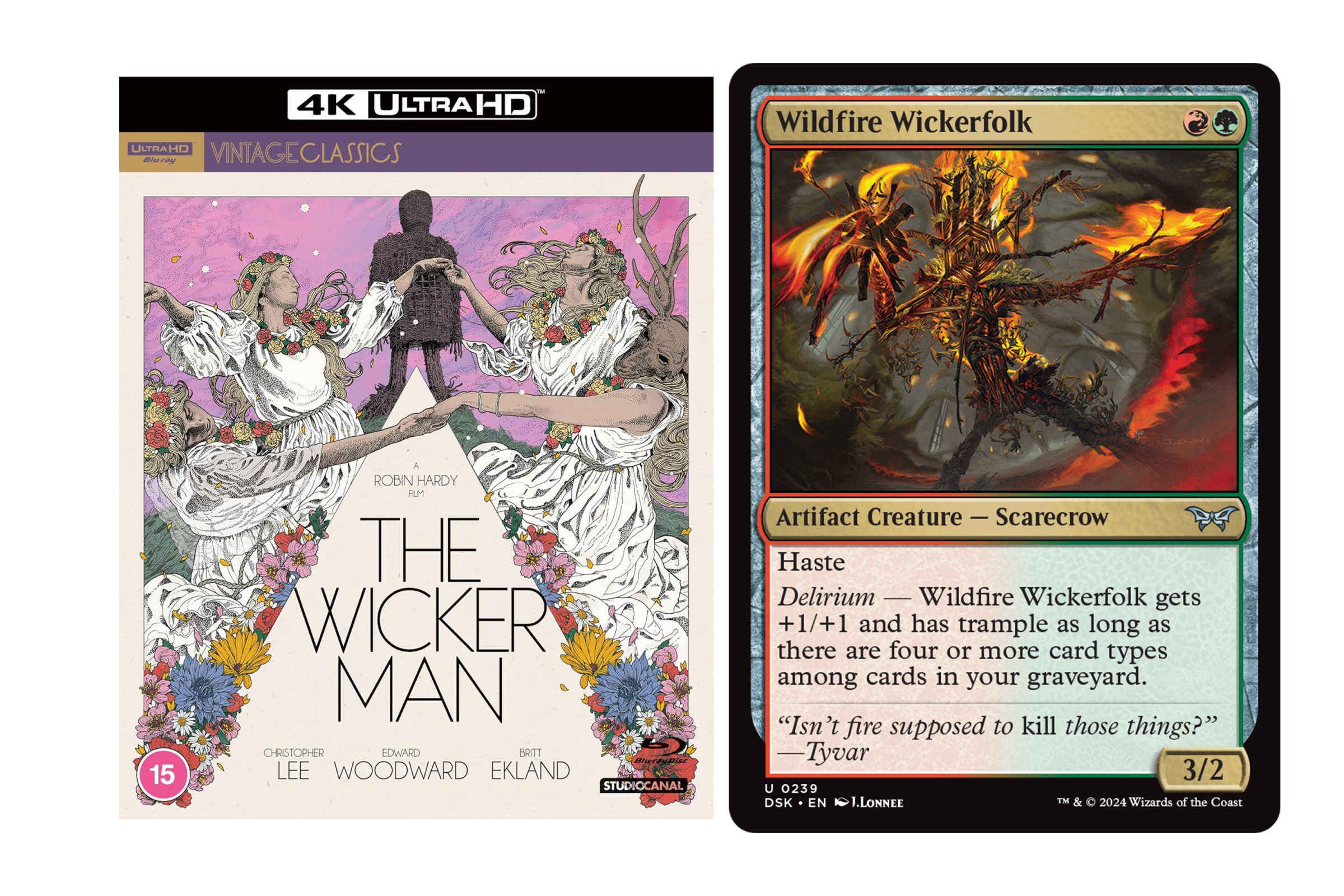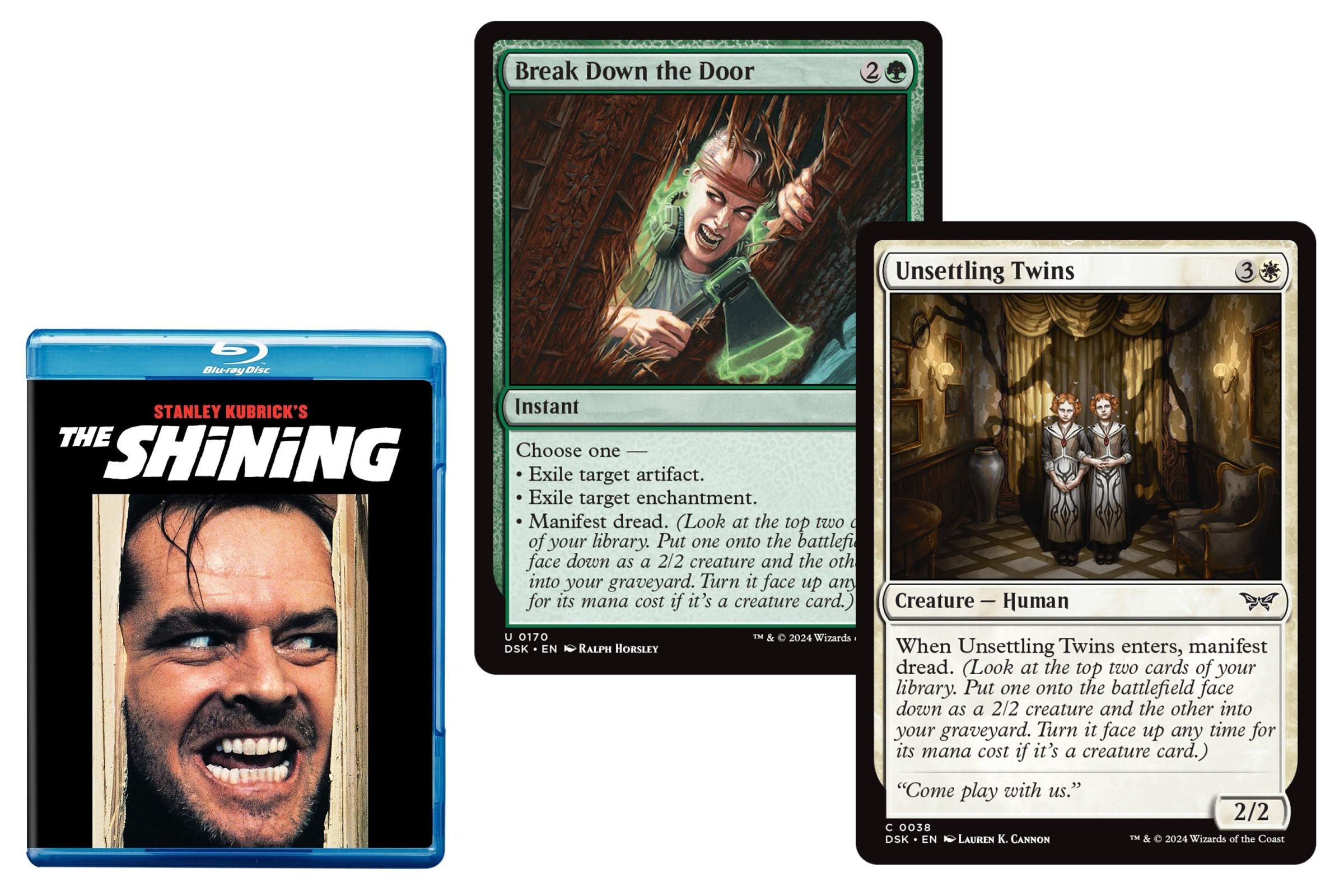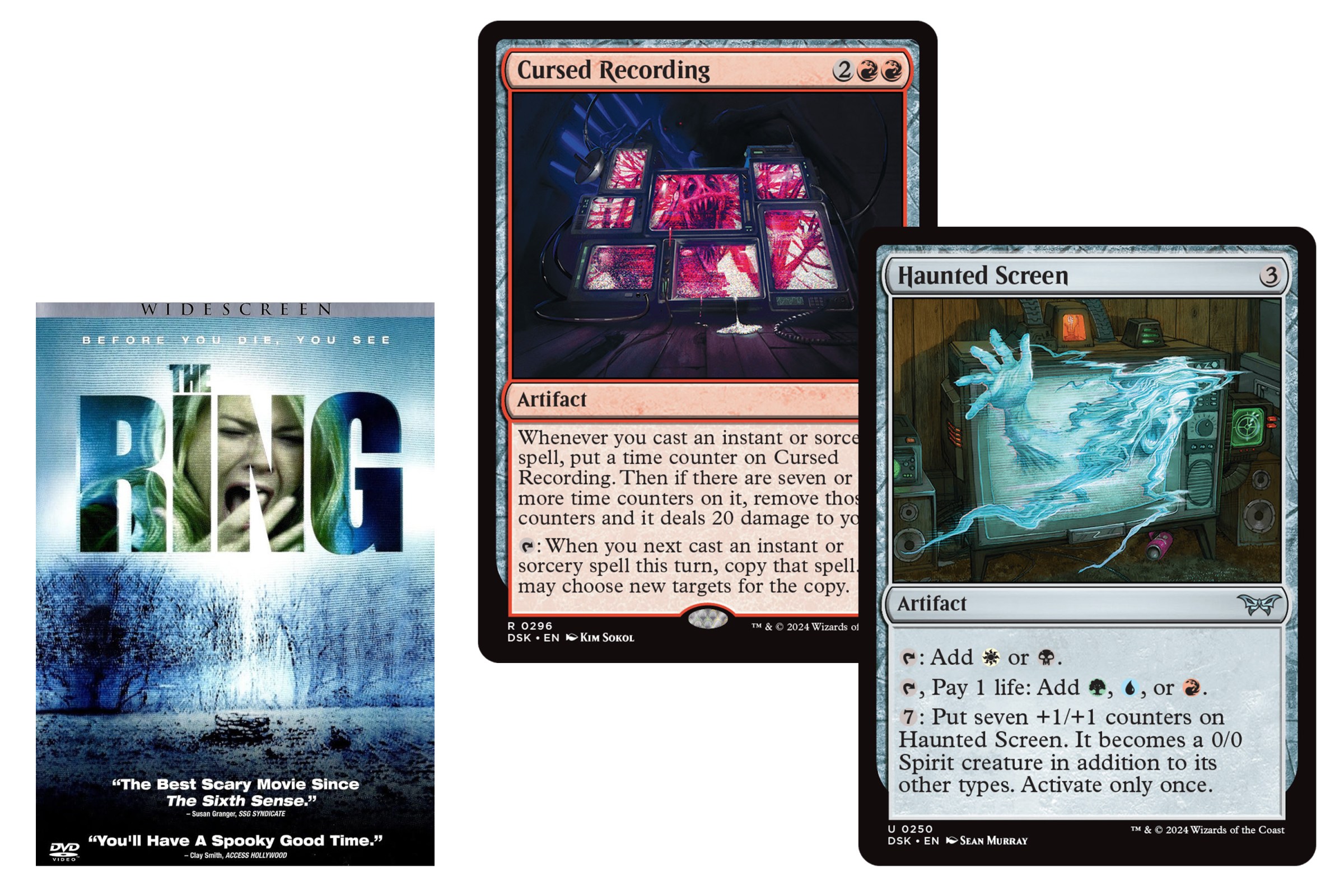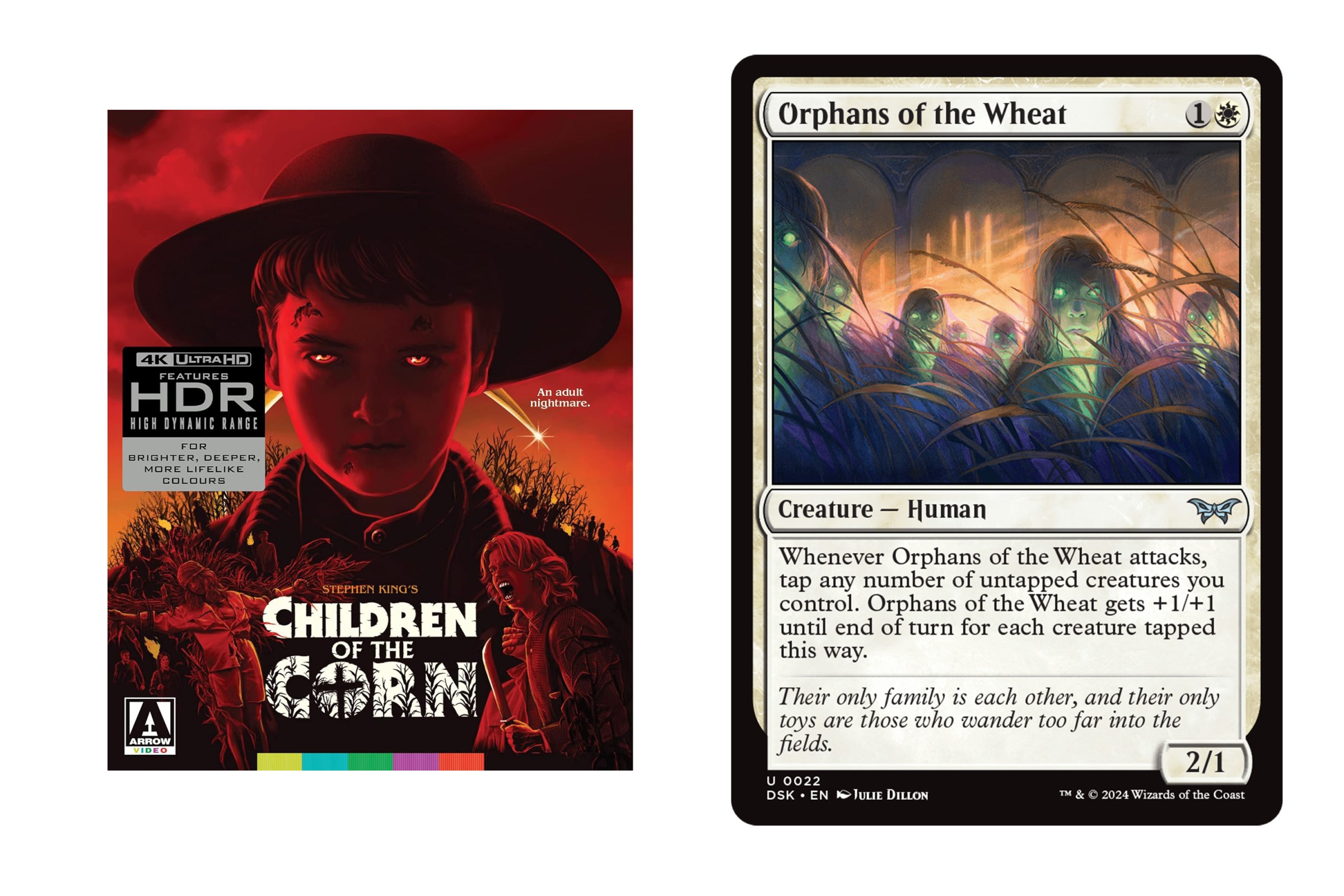The Top 5 Horror Movies to Pair With Magic: The Gathering’s New Set, Duskmourn
The upcoming release of Magic: The Gathering‘s new set, Twilight Mourningintroduces players to a brand-new plane of the multiverse set entirely within a sprawling haunted mansion. Filled with unspoken horrors, personified phobias, and ragtag human survivors, the set captures the spirit of Halloween and gamifies the spooky season. Looking through the new cards in the set, some of them feel strangely familiar. The names, art, and mechanics vaguely evoke memories of horror movies watched late at night when I should have been asleep.
Magic‘s publisher, Wizards of the Coast, is keeping tight-lipped about the specific inspirations that went into the design of the new cards and world. But for this horror fan, these preview cards are at least a welcome reminder to revisit some of the genre’s most beloved masterpieces and cult classics. Like the perfect glass of blood-red wine to enjoy with your bowl of spiders and eyeballs, here are five horror movie pairings to enjoy alongside Magic‘s most gruesome expansion yet.
The Gate with Clammy Prowler
In the 1987 supernatural horror film The Gatea pair of 12-year-olds named Terry and Glen accidentally unleash a horde of demons through a hole in Glen’s backyard. The climax revolves around Glen’s attempt to stop a giant snake-like demon with a toy rocket launcher (more of a model rocket than a bazooka, but definitely a projectile no 12-year-old should be playing with).
The Gate is a pretty forgettable film, but I was reminded of it when I saw the art on Clammy Prowler . The hole in Glen’s backyard glows a similar magenta hue just before a small army of tiny demons emerge and attack the film’s cast of children. And the prowler itself, with its oversized claws, pointy head, and tiny extra hands, is reminiscent of the giant final demon that Glen must defeat with his toy rocket.
The Wicker Man (1973) with Wildfire Wickerfolk
If you haven’t seen the 1973 British folk horror classic The Wicker ManYou may remember the 2006 remake of the same name starring Nicolas Cage. Both films tell the story of a police officer who visits a remote island in search of a missing girl. As the film’s protagonist explores the unfamiliar surroundings and its unusual inhabitants, he eventually uncovers a deeper mystery involving the islanders’ pagan rituals surrounding crop failures (or in the 2006 version, declining honey production).
Unfortunately for the agents in this story, their arrival on the island is part of a larger plan. They are eventually sealed inside a giant wooden statue, the eponymous Wicker Man, and ceremonially burned as part of a sacrificial ritual.
Not only the art on Twilight Mourning‘s Wildfire Wickerfolk harks back to the wooden effigies central to the climaxes of both films, each made of reeds and clearly aflame, its additional Delirium ability granting the creature an extra advantage when there are enough other cards in the graveyard. Like the sacrificed police officers in those spooky films, Wildfire Wickerfolk must have additional “dead” cards in the graveyard to see its own in-game potential.
The Appearance with Unsettling Twins and Break Down the Door
In Stanley Kubrick’s influential 1980 film adaptation of Stephen King’s The Appearance, Jack Nicholson stars as Jack Torrance, a struggling author who moves his family into an empty hotel so he can focus on overcoming a nagging bout of writer’s block. But as his wife and son, Wendy and Danny, soon discover, the hotel has a sinister effect on Jack’s mental health, and he eventually goes on a killing spree, attacking his wife and son with an axe.
The film has contributed to countless classic images that have found their way into contemporary pop culture, including a fan favorite Simpsons parody in “Treehouse of Horror V.” More than 40 years later, some of those unmistakable images have surfaced on the Internet. Magic cards in Twilight Mourning.
The characters in Unsettling Twins may not resemble the girls in blue dresses Danny encounters as he rides his tricycle through the streets of New York. The Appearance‘s Overlook Hotel, but the flavor text on the menu is unmistakable. “Come play with us,” Danny hears, followed by shocking images of the girls’ gruesome fate.
The art on Break Down the Door similarly evokes one of The Appearance‘s most iconic images, of Jack bursting through a door with an axe during his latest psychotic outburst. It remains unclear whether the character in the art is chasing a terrified Shelley Duvall or a MTG character who is better prepared for combat.
The Ring (2002) with Cursed Recording and Haunted Screen
Twilight Mourning introduces television to the world of Magicwhich is a strange thing to do after 35 years of the franchise. Anyway, some of those cards reminded me of how horror movies play on the fear of screens, and none do it more memorably than The Ring.
In 2002 The Ring, an American remake of a 1998 Japanese film, also known as Ringa haunted videotape curses people to die seven days after the tape is viewed. The victims die from initially mysterious causes, which later turn out to be a tormented spirit emerging from a television screen to actually scare its victims to death.
Perhaps what makes the allusions to Cursed Recordings and Haunted Screen so satisfying is that The Ring‘s inspiration is also felt in the mechanical design of the cards. Like the videotape in The RingCursed Recording challenges you to win the game as quickly as possible, as it will eventually deal 20 damage, often enough to kill you, after you cast seven instant or magic spells.
Haunted Screen, on the other hand, takes its inspiration a step further. Not only can the card tap for black and white mana, you can also pay for it with your life total to provide additional colors. Eventually, you can even make Haunted Screen a full-on threat by investing seven mana into it to turn it into a 7/7 spirit creature — easily big enough to kill your opponents with just a few attacks if they don’t give in to fear beforehand.
Children of the corn (1984) with Creatures of the Wheat
Another adaptation of a Stephen King work, from 1984 Children of the corn tells the story of a rural Nebraska community that is taken over by a religious cult of children who have sworn allegiance to a false deity and sacrifice the town’s adults to ensure the success of the community’s corn crop. Orphaned by their own actions, the film chronicles the community’s eventual collapse when a pair of travelers stop in town and ultimately burn down the cornfield that houses the evil presence that has influenced the children.
Between the card’s name, its art, and even its ability, Orphans of the Wheat bears an undeniable resemblance to Children of the Corn.
In the film’s opening scene, a young boy named Isaac Croner peers into a village inn as adults collapse from drinking poisoned coffee. His haunted gaze, immortalized in the film’s promotional art, bears an eerie resemblance to the characters depicted in Orphans of the Wheat . Even the text on the card feels thematically connected. Like the film’s children, who grow stronger as the village adults are killed, so too do the orphans, who, during in-game battles, become pumped up for each other’s creature, which drains the card’s controller during attacks.
And don’t get me started on the name of the card. Structurally. Phonetically. The only other name that might have been more on the nose was Kids of the Crop, but thankfully MagicThe designers of were more creative than that.
Twilight Mourning will be released in local game stores from September 27, following the pre-release events that start on September 20.




